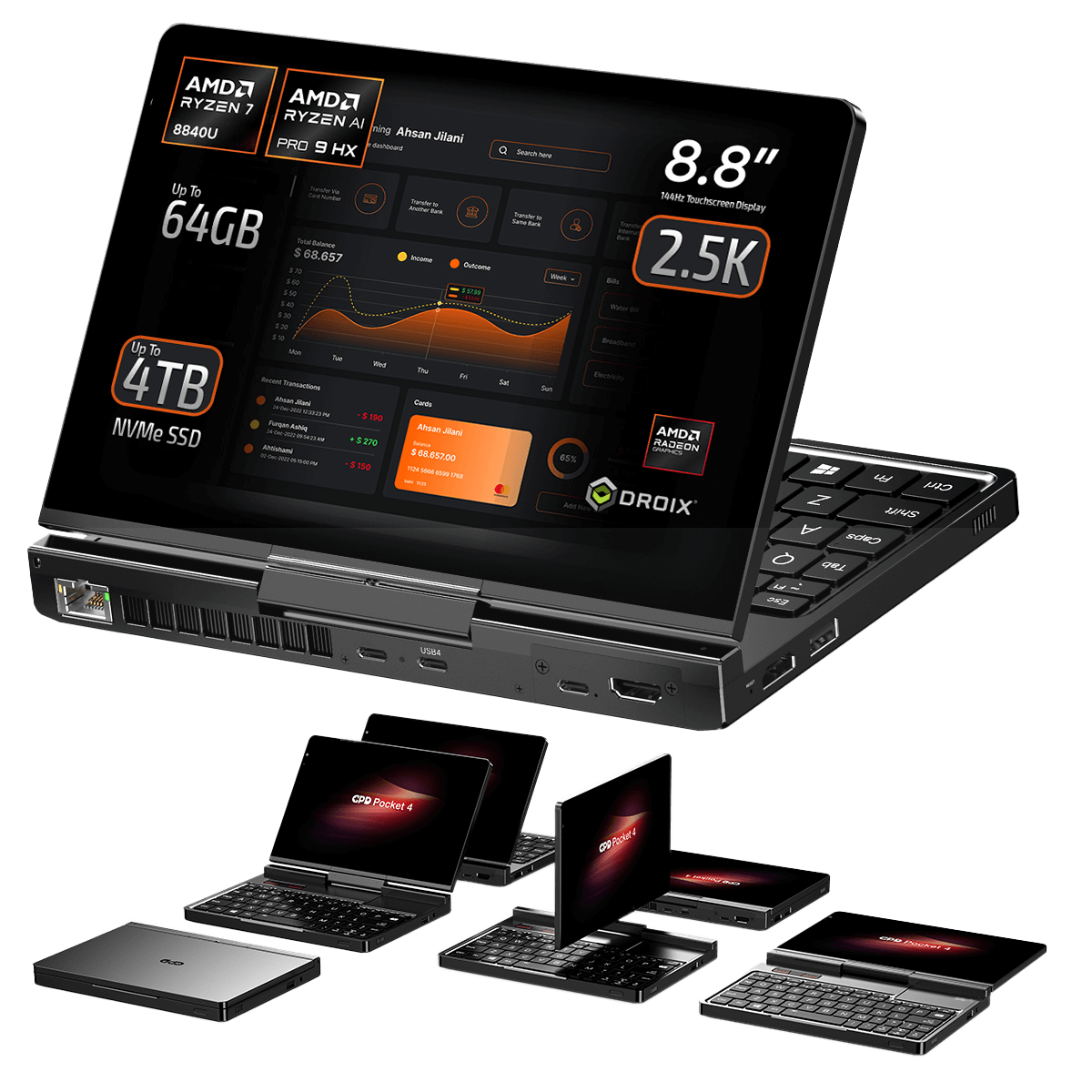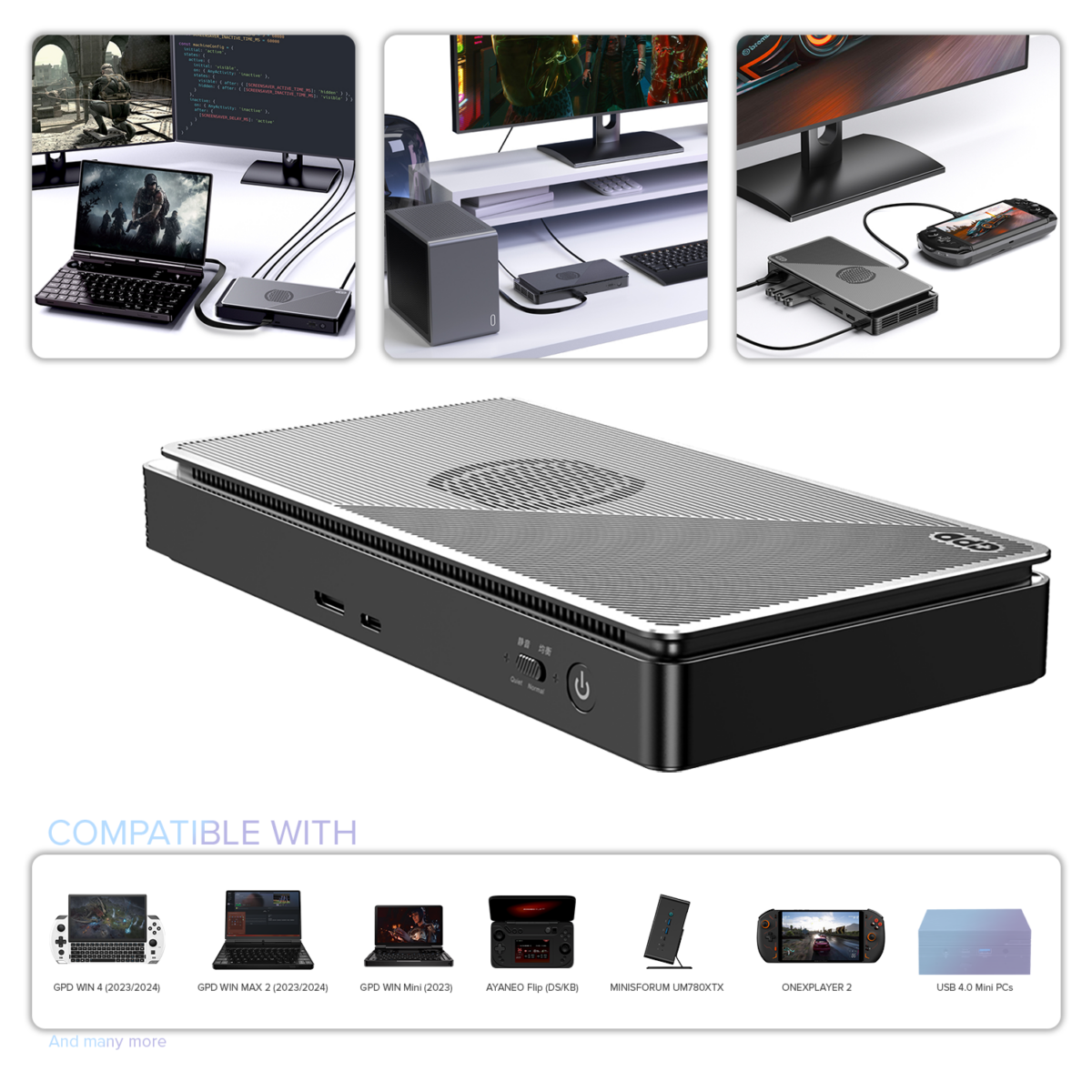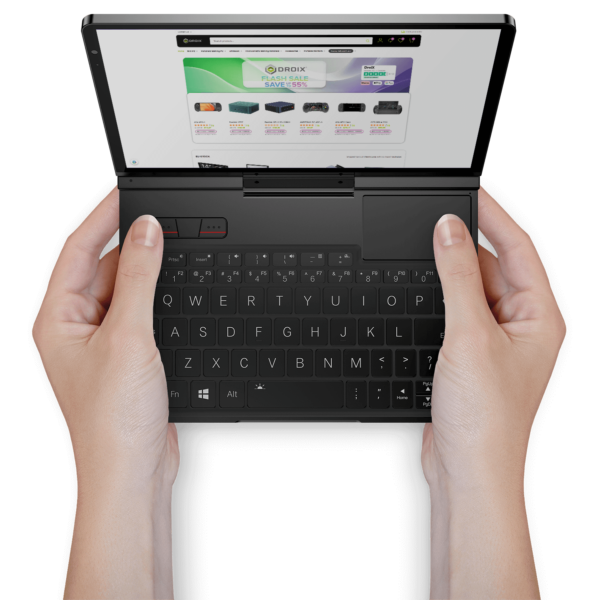
The Future of Mini Laptops and Handheld PCs for Gaming: Trends to Watch in 2024/2025 and Beyond
The mini laptop and handheld PC for gaming market is poised for significant advancements in 2024 and beyond, with GPD leading the charge by incorporating AMD’s powerful Ryzen AI 9 HX 370 processor into their upcoming devices. The GPD Duo and GPD Pocket 4 are set to be the first devices to feature this cutting-edge chip, promising enhanced performance and AI capabilities that could reshape the landscape of portable gaming and productivity.
The Rise of AMD Ryzen AI 9 HX 370 in Handheld Devices
The AMD Ryzen AI 9 HX 370 processor represents a significant leap forward in mobile computing technology, particularly for handheld gaming devices and laptops. This chip, part of AMD’s Strix Point family, combines advanced CPU and GPU capabilities with dedicated AI processing, making it a powerful contender in the rapidly evolving handheld PC for gaming market. At the heart of the Ryzen AI 9 HX 370 is a hybrid core architecture, featuring 4 Zen 5 cores and 8 Zen 5c cores, for a total of 12 cores and 24 threads. This configuration allows for a balance between high-performance computing and power efficiency, crucial for handheld devices. The processor boasts a base clock of 2.0 GHz and can boost up to 5.1 GHz, providing ample processing power for demanding tasks and games.

One of the most notable features of the HX 370 is its integrated Radeon 890M graphics, based on the RDNA 3.5 architecture. With 16 compute units and a clock speed of up to 2,900 MHz, this iGPU represents the most powerful integrated graphics solution AMD has ever released for mobile devices. This significant boost in graphics performance is particularly exciting for handheld gaming PCs, as it promises to deliver frame rate improvements of up to 33% compared to previous generations.
The chip also incorporates AMD’s XDNA 2 architecture for AI processing, capable of delivering 50 TOPS (Trillion Operations Per Second) of AI performance. This dedicated Neural Processing Unit (NPU) enables advanced AI features directly on the device, potentially enhancing gaming experiences through AI-driven graphics improvements, adaptive gameplay, and more sophisticated in-game.

GPD DUO
AI Energy efficiency is a crucial factor for handheld devices, and the Ryzen AI 9 HX 370 addresses this with a configurable TDP range of 15-54W. This flexibility allows device manufacturers to optimize power consumption based on their specific design requirements and thermal solutions. The adoption of the Ryzen AI 9 HX 370 in handheld devices is already underway. GPD, a prominent player in the handheld PC market, has announced that their upcoming GPD Duo and GPD Pocket 4 will be the first devices to feature this processor. This move signals a potential shift in the handheld gaming PC landscape, as manufacturers look to leverage the HX 370’s powerful combination of CPU, GPU, and AI capabilities.
The integration of such a powerful chip in handheld form factors does raise questions about thermal management and battery life. However, AMD’s focus on efficiency with the Zen 5 and Zen 5c cores, combined with the configurable TDP, suggests that manufacturers will have the flexibility to balance performance and power consumption effectively

As the mini laptop and handheld gaming PC market continues to grow, the Ryzen AI 9 HX 370 is poised to play a significant role in shaping the next generation of devices, competing with offerings from ASUS and other major brands. Its combination of high-performance computing, advanced graphics capabilities, and dedicated AI processing could enable more console-like gaming experiences on the go, while also opening up new possibilities for productivity and creative applications in portable form factors
Exploring AI Trends in Next-Gen mobile devices
Artificial Intelligence (AI) is significantly reshaping the PC landscape by introducing immersive and personalized experiences through advanced AI technologies. The incorporation of dedicated AI processors, like the Neural Processing Unit (NPU) in the AMD Ryzen AI 9 HX 370, represents a key trend. This NPU, with its capacity for 50 trillion operations per second, enables real-time enhancements directly on the device, improving gameplay, graphics, and user interaction. AI-powered features such as AMD FSR, which upscales images for better graphics, are becoming increasingly prevalent, especially in handheld gaming devices, offering high-quality visuals on power-constrained platforms.

AI is also revolutionizing gameplay dynamics and interaction with non-player characters (NPCs). Adaptive gameplay algorithms adjust game difficulty and storylines based on player behavior, creating a more personalized experience. Advanced AI allows NPCs to exhibit complex behaviors and learn from player interactions, making in-game interactions more engaging. Additionally, AI-driven procedural content generation can automatically create game content, reducing development time while offering players nearly limitless exploration possibilities. Enhanced voice and natural language processing are making voice commands and AI-assisted gameplay more intuitive and seamless in future gaming devices.
While AI offers numerous benefits, it also brings challenges that need addressing. The integration of AI capabilities directly into processors, like the AMD Ryzen AI series, reduces reliance on cloud processing, allowing for more sophisticated features on handheld PCs for gaming. However, this also raises concerns about data privacy, ethical implications of AI-generated content, and the potential for AI to be used in creating addictive gameplay mechanics in the gaming industry. As these technologies evolve, developers and manufacturers must navigate these challenges to harness AI’s potential fully. Despite these concerns, AI is set to deliver more immersive, personalized, and intelligent gaming experiences, making future gaming PCs more adaptive to individual players’ needs and preferences.
GPD Duo: The Dual Display Revolution
The GPD Duo represents a significant leap in dual-screen laptop technology, offering a unique combination of versatility and power. This innovative device features two 13.3-inch OLED displays, each boasting a resolution of 2560 x 1600 pixels and a 16:10 aspect ratio. When fully extended, the GPD Duo provides an impressive 18-inch display area, expanding the visual experience for users. The dual AMOLED screens, dubbed “Aurora Displays” by GPD, offer exceptional visual quality with a 1,000,000:1 contrast ratio and 100% coverage of the Adobe RGB color space. These displays support 10-point touch input and are compatible with stylus pens, offering 4096 levels of pressure sensitivity. This feature makes the GPD Duo particularly appealing to artists, designers, and note-takers.

One of the most innovative aspects of the GPD Duo is its flexible design. The secondary screen can rotate 360 degrees, allowing the device to transform from a traditional laptop into a tablet-like form factor. This versatility enables users to experience various operating systems in tablet mode, including Linux and macOS, through virtual machine support. The GPD Duo is powered by the AMD Ryzen AI 9 HX 370 processor. It can be configured with up to 64GB of LPDDR5x memory and 4TB of SSD storage, with an additional unoccupied PCIe 4 M.2 NVMe 1.4 slot for further expansion.
Connectivity is a strong suit of the GPD Duo, featuring an array of ports including USB4, HDMI, Ethernet, and an OCuLink port for eGPU expansion. The device also supports Wi-Fi 6E and Bluetooth 5.3 for wireless connectivity. The GPD Duo is equipped with an 80Wh battery and supports 100W Super Fast Charging GPD claims an impressive battery life of up to 30.2 hours on a single charge, although real-world usage may vary. While the GPD Duo offers a unique and potentially game-changing design, some concerns have been raised about its practicality. The tablet mode, for instance, has been described as potentially awkward, likened to “carrying a pile of tablets that don’t sit nicely on top of each other”.

However, the true usability of the device will only be determined once it’s available for hands-on testing. As of now, GPD has not announced official pricing or availability for the Duo. The GPD Duo represents a bold step forward in mini laptop design, potentially offering a new level of flexibility and functionality for power users, creatives, and multitaskers, especially for productivity.
GPD Pocket 4 Modularity
The GPD Pocket 4 marks a significant advancement in the 2-in-1 mini laptop and tablet market, particularly for industrial and professional use. One of its most innovative features is the modular port system, which allows users to customize the device according to specific industry needs. The Pocket 4 can be equipped with additional USB-C ports, a capture card module, an RS-232 serial port module, or a KVM (Keyboard, Video, Mouse) control module. This flexibility makes it an ideal tool for IT professionals, industrial applications, and specialized fields where specific connectivity options are crucial.

Another key feature of the GPD Pocket 4 is its 2-in-1 functionality, allowing it to function as both a mini laptop and a tablet. The device boasts an 8.8-inch LTPS display with a high resolution of 2560×1600 and a 144Hz refresh rate, which can rotate to switch between modes. This versatility is particularly beneficial in professional settings where the ability to quickly shift between different modes of operation can enhance productivity. Whether used for fieldwork in tablet mode or more traditional tasks in laptop mode, the Pocket 4 adapts to various use cases, providing flexibility that is highly valued in industry environments.

GPD Pocket 4 Mini Laptop
The GPD Pocket 4 is designed with the demanding requirements of industry professionals in mind. Its powerful AMD Ryzen AI 9 HX 370 processor, along with up to 64GB of RAM and expandable storage up to 4TB, equips the device to handle resource-intensive tasks typically reserved for full-sized laptops. This makes the Pocket 4 a strong contender for use in industries where performance cannot be compromised, despite the need for a compact, portable device favored by professionals. The inclusion of advanced graphics capabilities, such as the AMD Radeon 890M iGPU, further enhances its suitability for graphics-intensive applications in professional environments.

Overall, the GPD Pocket 4 sets a new standard originally created by the GPD Pocket 3 in the UMPC market by combining high performance, modular design, and versatile functionality. Its ability to cater to niche professional markets, particularly those requiring specialized connectivity and adaptability, reflects GPD’s commitment to pushing the boundaries of ultra-portable computing. The GPD Pocket 4 is not just a powerful productivity tool; it is a versatile, industry-focused device that meets the evolving needs of professionals in various fields, making it a valuable asset in the modern workplace.
GPD WIN 5 Rumors
There are rumors circulating about the upcoming GPD Win 5, expected to be the latest in GPD’s popular handheld for PC gaming lineup. While nothing has been confirmed by GPD, it is speculated that the device will feature the same AMD Ryzen AI 9 HX 370 processor. The device is anticipated to offer a new design with various improvements in display, ergonomics, and cooling, making it a powerful contender in the handheld gaming market, particularly for gamers who demand high performance. However, official details are still awaited. We have a more in-depth article on the GPD WIN 5 rumours here.
eGPU Docking Stations
The growth of external GPUs (eGPUs) is set to accelerate in 2024 and 2025, fueled by the increasing demand for portable devices that can handle both gaming and professional tasks. The ONEXPLAYER ONEXGPU 2 exemplifies this trend, featuring advanced cooling solutions, improved connectivity, and compatibility with the latest AMD Radeon RX 7800M GPU, significantly enhancing graphical performance. This eGPU is expected to deliver a major boost not only in gaming but also in productivity tasks like video editing and 3D rendering, making it a versatile tool for both gamers and professionals.

The ONEXGPU 2 builds on its predecessor by supporting higher data transfer rates and more efficient power management, ensuring smoother performance in resource-intensive applications. This makes it ideal for users who require desktop-level graphics performance in a portable setup. Paired with devices like the GPD WIN Mini 2024 or even the forthcoming GPD Duo and other compatible laptops, it can handle AAA gaming titles with ease, while also accelerating tasks such as video editing, allowing for faster rendering times and more fluid workflow in creative applications.

GPD G1 (2024) eGPU Docking Station
Additionally, the GPD G1 eGPU docking station series is expected to continue to be a significant player in this growing market. We would expect an upgraded model with the AMD Radeon RX 7800M GPU. This eGPU is not only set to elevate gaming experiences with higher frame rates and better visuals but also enhance productivity tools, enabling professionals to tackle demanding tasks like 4K video editing, complex simulations, and graphical design on the go. As these eGPUs evolve, they will become indispensable for users seeking high performance in compact, portable systems.
Future Tech Trends 2024-2025
The handheld gaming PC and mini laptop markets are poised for significant advancements in 2024 and 2025, driven by improvements in CPU performance, AI capabilities, and innovative form factors. The AMD Ryzen AI 9 HX 370 processor is set to play a crucial role, offering powerful CPU and GPU performance alongside dedicated AI processing capabilities. This chip is expected to enable more console-like gaming experiences on devices like the Xbox and PlayStation, along with advanced AI features in portable devices. AI integration is becoming increasingly prevalent, with trends like AI-enhanced graphics, adaptive gameplay, and procedural content generation shaping the future of mini laptops and gaming handhelds.
Dual-display laptops are emerging as a new trend, exemplified by devices like the GPD Duo offering expanded display areas and versatile form factors GPD continues to innovate with the Pocket 4, featuring a modular port design for industrial applications, and rumors suggest the upcoming GPD WIN 5 may include further improvements in display technology and cooling systems. These developments collectively point towards a future where handheld and portable PCs offer increasingly powerful, versatile, and AI-enhanced experiences, blurring the lines between mobile and desktop computing.
Reader Discussion: Future Handhelds
As we look towards 2025, the landscape of handheld gaming PCs and laptops is ripe for innovation. We’d love to hear your thoughts in the comments on what you hope to see in 2025. Are you excited about the potential of AI-enhanced gaming experiences, or are you more interested in advancements in battery life and portability? Perhaps you’re eager for more powerful graphics capabilities that can rival traditional gaming consoles, or maybe you’re intrigued by the possibilities of modular designs like those seen in the GPD Pocket 4
Share your ideas and wishlist for the future of portable devices in the comments. Whether it’s about hardware specifications, software integration, or entirely new form factors. Your input could provide valuable insights into the direction this exciting technology might take in the near future.


